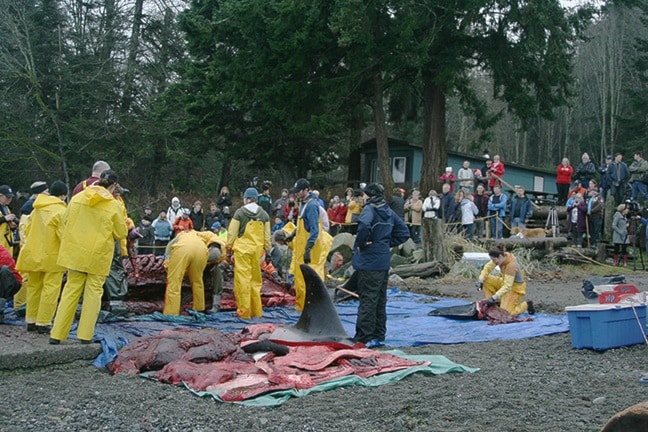The Department of Fisheries and Oceans Canada is asking for the public’s help in finding the person responsible for removing teeth from a dead orca found near Courtenay awaiting a necropsy.
The killer whale, known as J-32 or Rhapsody, was a southern resident orca found Thursday afternoon near Bates Beach. The 19-year-old mammal was brought ashore and transported to a nearby boat launch where it was examined by biologists for a post-mortem exam Saturday.
Sometime overnight Friday or early Saturday morning, someone broke off several teeth and cut off others from the lower jaw of the whale, explained Paul Cottrell, marine mammals co-ordinator for the Department of Fisheries and Oceans.
“Everyone feels so bad; we didn’t think someone would do that,” he added.
“The poor animal was in the prime of its life.”
Cottrell confirmed DFO does have leads which they are pursuing, and noted desecrating the orca is unlawful under Section 32 of the Species At Risk Act.
The section notes it is an offence to possess, collect, buy sell or trade an individual of a listed species that is extirpated, endangered or threatened, or its part or derivative.
Until J-32’s death, it was believed there were 78 southern resident orcas in the wild.
The law carries various punishments, depending on if the violation was done by a corporation or an individual. In the case of a corporation, a fine of no more than $1 million can be imposed, and in the case of an individual or a non-profit, a fine of no more than $250,000 or imprisonment of no more than five years or both.
Cottrell explained while exceptions can be made for scientific research and examination or First Nations ceremonies, special applications need to be made.
Marcie Callewaert, founder of the Victoria Marine Science Association, told CTV News Vancouver Island it is a crime that can’t be described.
“It’s a crime against science, it’s a crime against her and the respect for Rhapsody and I really hope they’re caught and it’s not okay.”
Cottrell added any leads from the public will hopefully aid in finding the person responsible and noted he suspects the incident happened between 10 p.m. Friday and 4 a.m. Saturday.
“It happened in an area that was cordoned off on private land. The person definitely made an effort to get there.”
Anyone with information about the incident is asked to call the Observe, Record and Report (ORR) line at 1-800-465-4336.
• • •
With approximately a dozen marine biologists surrounded by curious onlookers, the necropsy Saturday on the beach revealed the orca was pregnant with a full-term female fetus.
The gestation period for killer whales is around 17 months.
“It definitely looks like the pregnancy may have been a significant issue with the death of J-32 but until (the pathologist) has put together the pieces, we won’t know for sure,” explained Cottrell.
He noted biologists are looking at the whale to determine if she had been pregnant previously.
“At this point we don’t know, but the samples have to be looked at microscopically.”
Cottrell said while they have performed three killer whale necropsies within the past year and a half, they were all older animals without pregnancies and from other pods.
He added the southern residents pod now contains between 16 to 19 females who can reproduce.
“… when you take out a female who is just becoming sexually mature and contribute for a couple of decades, it’s a big loss. Her calf production won’t be there … every calf is just so important going forward.
While it may take some time to determine the full results of the post-mortem exam, Callewaert, who travelled from Ahousaht to the Comox Valley to see Rhapsody, said it was important for her to be there.
“I’ve been closely connected to the southern residents since I was a young child. I’ve spent the last three summers out on the water with them. I’ve seen Rhapsody breach, I’ve seen members of her family …(I came) to respect what she’s given to us through her death and to pay tribute to her.”
She said to see the animal on land is heart wrenching, particularly the process of the necropsy, but understands the data her death provides is invaluable.
Callewaert noted both deaths (J-32’s and the fetus) are very significant to the southern resident pod.
“The recovery plan (was) to have 115 southern residents by 2015; we’re down to 77. Something isn’t working … we’re going to lose them if we’re not careful.”
The skeletons of J-32 will be donated to the Royal B.C. Museum.
